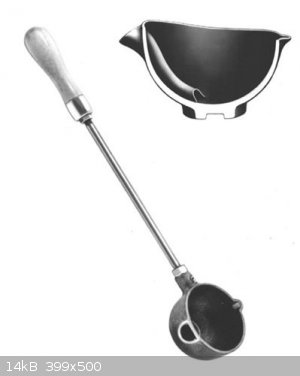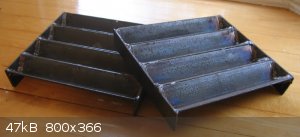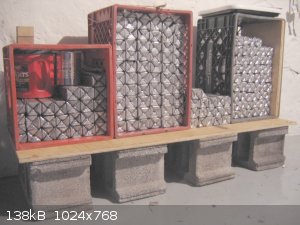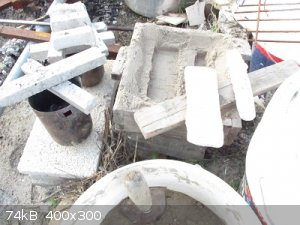ElchScience
Harmless

Posts: 17
Registered: 14-8-2016
Member Is Offline
Mood: No Mood
|
|
Lead refining failures
Hello everybody!
I tried recorvering some pure lead from range scrap in this video:
https://youtu.be/_KqRFpDpKoo
As you can see I might have messed up a little.
The question I wanted to ask if anybody has a good idea on how to extract the remaining 4kg of lead. I though of something like using Acetic acid to
dissolve it and then get it back purified via elektrolysis. Does anybody have any better ideas?
My main worry with that is that the acetic acid when heated is going to dissolve copper and brass from the bullet shells too and ruin everything. You
might be able to precipitate the copper out of solution using citric acid though.
|
|
|
Chlorine
Hazard to Self
 
Posts: 56
Registered: 26-11-2016
Location: Maine, USA
Member Is Offline
Mood: Brominated
|
|
The easiest way to process the range scrap is via melting, most back yard foundaries will be able to melt lead, you just need to make sure you
separated the rocks and the rounds. It wouldnt be practical to use any acids. I speak from experience when I say that melting works the best.
|
|
|
NitratedKittens
Hazard to Others
  
Posts: 131
Registered: 13-4-2015
Location: In the basket with all the other kittens
Member Is Offline
Mood: Carbonated
|
|
But how will melting purify lead
Basket of kittens for you ........BOOM
|
|
|
Texium
Administrator
       
Posts: 4516
Registered: 11-1-2014
Location: Salt Lake City
Member Is Offline
Mood: PhD candidate!
|
|
Melting lead will purify it to an extent because the non metallic slag will float to the top where it is easily scraped off. It will not remove
metallic impurities though. Most commercial lead is alloyed with antimony to harden it, and this will stay with the lead when melted. The only way to
remove it as far as I know is by dissolving the lead in nitric acid. The antimony is oxidized and precipitates as antimony trioxide, which can be
saved for other experiments.
Acetic acid alone will not dissolve lead. Peracetic acid will react vigorously with lead to give some lead acetate, but mainly it seems to yield an
insoluble oxyacetate. Nitric acid is really the only surefire way of dissolving lead.
|
|
|
Bert
Super Administrator
        
Posts: 2821
Registered: 12-3-2004
Member Is Offline
Mood: " I think we are all going to die. I think that love is an illusion. We are flawed, my darling".
|
|
FYI- Melting and then FLUXING the lead to reduce the oxides will provide a bit better economy... Cover the surface of the melted lead with a good
layer of sawdust, or some other carbonaceous material and stir with a wooden stick, perhaps even add a few chunks of beeswax or paraffin if
particularly oxide contaminated. The ash and carbonized sawdust layer remaining floating on top will help keep the Lead/Lead alloy somewhat protected
from O2 and provide some protection from re-oxidizing while you work with it.
Molten Lead is best poured from the BOTTOM of a smelter or ladle, with such a protective layer floating on top- Tools like these are nice.
Rowell Ladle:
(Edit)
Watched your video. Safety comments left on video... You were damned lucky not to be hurt badly, be more thoughtful and prepare better next time.
[Edited on 28-11-2016 by Bert]

Rapopart’s Rules for critical commentary:
1. Attempt to re-express your target’s position so clearly, vividly and fairly that your target says: “Thanks, I wish I’d thought of putting it
that way.”
2. List any points of agreement (especially if they are not matters of general or widespread agreement).
3. Mention anything you have learned from your target.
4. Only then are you permitted to say so much as a word of rebuttal or criticism.
Anatol Rapoport was a Russian-born American mathematical psychologist (1911-2007).
|
|
|
aga
Forum Drunkard
    
Posts: 7030
Registered: 25-3-2014
Member Is Offline
|
|
What a superbly simple idea !
Gotta make me one of those ladles.
A bit of annealed copper pipe should do for the spout.
|
|
|
aga
Forum Drunkard
    
Posts: 7030
Registered: 25-3-2014
Member Is Offline
|
|
LOL.
I just watched the video too. Dangerous, but entertaining.
Nice to see you guys learning (albeit slowly !) and enjoying lead casting.
Some PPE would have saved your Eyes if those lead-bombs had exploded at a slightly different angle.
Heating the mould is obviously a good plan, as you discovered.
Scraping the dross (s**t) off the top of the melt with a spoon is a good way to remove a lot of impurities.
Putting a steel lid on top of the crucible stops bits of wood and charcoal getting from the fire.
Finally, round pancakes are hard to get back into the crucible, so get some sand and make rod or bar shaped lead ingots instead. Even small 'muffin
tin' shapes fit easier, and they are not so heavy.
Please DO NOT try melting aluminium, brass, copper or steel before you get used to how molten lead works, or before you buy some protective clothing !
(some of those mistakes Could have ended up with someone Very badly hurt if it was Al. Certainly someone permanently damaged if it was Cu or Fe)
|
|
|
Bert
Super Administrator
        
Posts: 2821
Registered: 12-3-2004
Member Is Offline
Mood: " I think we are all going to die. I think that love is an illusion. We are flawed, my darling".
|
|
Angle iron makes a nice ingot mould, the ingots stack and interlock very nicely- See the pictures attached. Remember, if you weld end plates onto
angle iron like this, do it at a slight angle (to provide what foundry workers call "draft"), easing removal of the solidified ingot-


Rapopart’s Rules for critical commentary:
1. Attempt to re-express your target’s position so clearly, vividly and fairly that your target says: “Thanks, I wish I’d thought of putting it
that way.”
2. List any points of agreement (especially if they are not matters of general or widespread agreement).
3. Mention anything you have learned from your target.
4. Only then are you permitted to say so much as a word of rebuttal or criticism.
Anatol Rapoport was a Russian-born American mathematical psychologist (1911-2007).
|
|
|
RogueRose
International Hazard
    
Posts: 1585
Registered: 16-6-2014
Member Is Offline
|
|
As Aga said, stay away from Al, brass and copper until you get more experience. You might be able to handle zinc as it acts a lot like lead in how it
melts.
A tip for melting lead (or any metal) is to put a lid on the crucible (tin can) to both block ash from falling in and it helps keep heat in unless it
is in an enclosed furnace surrounded/covered by flame.
If using a tin can it is best to take some pliers and pinch/crimp the little lip around the top (where the lid is attached) to make the pour much
smoother (doesn't get caught on the lip).
It is also better (IMO) to add the lead in stages like cover the bottom by 1/2 inch, melt, add about 1 cup of metal (like a measuring cup - 8 oz),
repeat. The molten lead will rise above melting point and quickly transfer the heat to the new lead. The thorough contact speeds the melting even
faster than adding it all at once. It doesn't hurt to preheat the lead pieces in a pan (maybe as the lid to the melt pot) so it needs less heat to
melt.
A good way to pour if you have no containers is to find flat, smooth concrete. sweep or vacuum the surface for best results. Pour a small sample to
see if it flows (if surface isn't flat it can run faster than water). You can pour long strips or little "dolips". It is best to have the metal as
close to melting point and not 100's of degrees over if pouring on concrete. A steel soup ladle works well for this.
I have taken hot zinc and poured it into a 5 gal bucket of ice water. the pour is a slow, thin stream and it makes some really interesting shapes.
Pouring too fast makes the pieces stick together but slower pouring gives pieces ~1-4g in size each. I think lead will act similarly to this and I am
curious if water temps will change the shape of the resulting metal. DO NOT EVER DUMP LOTS OF HOT METAL AT ONCE into water or ice it can explode or
cause flash steam burns. Pouring on fluffy snow would be interesting as well.
If you decide to work with brass, I would recommend A LOT of research prior as I found it much more difficult than any of the other metals mentioned
and have not yet successfully melted any. Zinc evaporates before copper melts so the Zn/Cu mixture of brass can lead to zinc boiling away and out of
the brass.
|
|
|
RogueRose
International Hazard
    
Posts: 1585
Registered: 16-6-2014
Member Is Offline
|
|
Quote: Originally posted by Bert  | Angle iron makes a nice ingot mould, the ingots stack and interlock very nicely- See the pictures attached. Remember, if you weld end plates onto
angle iron like this, do it at a slight angle (to provide what foundry workers call "draft"), easing removal of the solidified ingot-
|
Is that all lead? May we ask where you find sources for it? (PM me if you don't want to make it public).
I'd like to see a thread on refining battery plates from lead-acid batteries. Between the Lead sulfate and lead dioxide, it gets pretty tough but I'm
really interested in the procedure with proper equipment like kiln, furnace or forge and possibly carbon as a reducing agent or acids for dissolving.
|
|
|
Bert
Super Administrator
        
Posts: 2821
Registered: 12-3-2004
Member Is Offline
Mood: " I think we are all going to die. I think that love is an illusion. We are flawed, my darling".
|
|
That is not my personal stash of Lead- I have only got about 400 lb. or so on hand, plus perhaps another 100 of various type metal alloys and about
20 of Tin.
Where to find Lead? Tire shops. Scrap yards. Dead people whos survivors had no interest in bullet casting. Construction workers remodeling clinics
with shielded Xray rooms (that one was HUGE). Craig's List. Word of mouth. Scrounging in dumpsters.
Rapopart’s Rules for critical commentary:
1. Attempt to re-express your target’s position so clearly, vividly and fairly that your target says: “Thanks, I wish I’d thought of putting it
that way.”
2. List any points of agreement (especially if they are not matters of general or widespread agreement).
3. Mention anything you have learned from your target.
4. Only then are you permitted to say so much as a word of rebuttal or criticism.
Anatol Rapoport was a Russian-born American mathematical psychologist (1911-2007).
|
|
|
ElchScience
Harmless

Posts: 17
Registered: 14-8-2016
Member Is Offline
Mood: No Mood
|
|
Wow crazy amount of Feedback thank you guys so much for all this! :-)
About the safety concerns: Yes we are aware that we didn't do all of this as safe as we could have done it. Next time we will make sure to not let any
of these kind of failures happen. As for more safety equipment we are going to try to use a little more next time. You can't see it in the video but
we did put on safety googles so worst case would have been a scar in the face. I am glad you guys are worried about our health and we will try out
best. It is also in our best interest to not get hurt.
As far as crucible equipment and that kind of stuff goes: We didn't have any proper cast iron pots back then that we could use but now we do, so in
the future this shouldn't be a big deal. We also don't have proper welding equiptment so we can't make our own molds, but the idea with the angle iron
sounds really smart. Maybe a friend can help me with that. Thanks for the idea and all of the tips Bert!
I am not really convinced that the combination of molten metal and water is all to dangerous if the metal can't trap any of the water like in the
mold. The leidenfrost effect should help out with that a lot. I am not saying that you don't have to be careful though. Always have a lot more water
then molten metal and always be careful with anything you do!
Thank you Rogue Rose, aga and zts16 for all your tips!
Now back to my actual Problem of recovering the remaining 4kg or 9lbs of lead that are still in the scrap. They are very difficult remove by melting
it again. That is why I thought of using acid.
zts16 and Chlorine are you sure that it is not possible to dissolve the lead in acetic acid? I have read on a german website that you can do it with a
boiling solution of acetic acid. It could even be only 5% concentration. It apparently doesn't even require H2O2. Has anyone ever tried this? If not
I will give it a shot.
Or is there a better way to get the lead that is stuck to the other gunk?
Thanks again everybody for all the amazing feedback! I am learning a lot here!
[Edited on 29-11-2016 by ElchScience]
|
|
|
Texium
Administrator
       
Posts: 4516
Registered: 11-1-2014
Location: Salt Lake City
Member Is Offline
Mood: PhD candidate!
|
|
Quote: Originally posted by ElchScience  | | zts16 and Chlorine are you sure that it is not possible to dissolve the lead in acetic acid? I have read on a german website that you can do it with a
boiling solution of acetic acid. It could even be only 5% concentration. It apparently doesn't even require H2O2. Has anyone ever tried this? If not
I will give it a shot. |
I haven't tried it, but I would expect it to be quite a slow process.
|
|
|
aga
Forum Drunkard
    
Posts: 7030
Registered: 25-3-2014
Member Is Offline
|
|
Re-melt the lead and scrape off all the junk that floats.
This will remove the bulk impurites.
Cast the cleaner lead into beautiful Bert-style ingots 
If you have no mould, just use a bucket of slightly damp sand and press a shape into it with a stick.
The sand should be just damp enough so that it will hold a shape, but certainly not wet enough to stick to your hands.
Here's some Aluminium i did exactly that way (the sand-mould is something i just did to show you what i mean).

[Edited on 29-11-2016 by aga]
|
|
|
aga
Forum Drunkard
    
Posts: 7030
Registered: 25-3-2014
Member Is Offline
|
|
ANGLE IRON ! Of course !
Bert just gave me a great idea for another type of mould.
Cheers !
|
|
|
AJKOER
Radically Dubious
    
Posts: 3026
Registered: 7-5-2011
Member Is Offline
Mood: No Mood
|
|
One can dissolve Pb (or even Ag), per my reported experience on SM, in dilute acetic acid/H2O2 (or use an air pump, in place of replenishing the
H2O2, likely works also, but perform outdoors as Pb salt fumes should be avoided) plus an appropriate small amount of an electrolyte, after briefly
jump starting the electrochemical reaction in a microwave, fairly rapidly. One can effectively use critic acid to form citrates as well.
Generally, for the electrolyte, I would recommend NaCl or sea salt, except in cases where the associated metal chloride (like for silver and lead) are
insoluble, where I recommend KNO3 in place of NaCl.
Those in disbelief can forget the electrolyte and the microwave jump start and wait a week or more as I once did.
[Edit] I recall a reported instant of Lead induced brain fog suffered by a son helping his father who was breaking down Lead batteries, likely absent
appropriate safety equipment. I personally have decided to avoid experimenting with Pb salts (more of an issue of potential toxic exposure to others
and the environment).
[Edited on 30-11-2016 by AJKOER]
|
|
|
Liamatpm
Harmless

Posts: 48
Registered: 7-12-2016
Location: Maine
Member Is Offline
Mood: Using the process of cellular respiration to stay (barely) alive
|
|
I would recommend watch some Cody's Lab stuff on YouTube. He has videos on refining of metals.
|
|
|
Bert
Super Administrator
        
Posts: 2821
Registered: 12-3-2004
Member Is Offline
Mood: " I think we are all going to die. I think that love is an illusion. We are flawed, my darling".
|
|
Might I suggest something a bit older school, and less materials required if these guys want to do many kilos of scrap bullet metals containing Tin,
Antimony, Copper???
Liquation:
https://en.m.wikipedia.org/wiki/Liquation#/search
Rapopart’s Rules for critical commentary:
1. Attempt to re-express your target’s position so clearly, vividly and fairly that your target says: “Thanks, I wish I’d thought of putting it
that way.”
2. List any points of agreement (especially if they are not matters of general or widespread agreement).
3. Mention anything you have learned from your target.
4. Only then are you permitted to say so much as a word of rebuttal or criticism.
Anatol Rapoport was a Russian-born American mathematical psychologist (1911-2007).
|
|
|
aga
Forum Drunkard
    
Posts: 7030
Registered: 25-3-2014
Member Is Offline
|
|
I got ripped off with some lead i bought a while ago, which turned out to contain 4 sacrificial anodes for boats.
'Liquiation' looks like it might work for splitting out the component metals, one of which is a bar of steel ...
Thanks for the link Bert !
SM is priceless for Gems of knowledge like these.
|
|
|
aga
Forum Drunkard
    
Posts: 7030
Registered: 25-3-2014
Member Is Offline
|
|
Turned out that the sacrificial anodes were just Zinc with a steel bar thru the middle so it can be bolted onto a ship's hull.
Never cast Zinc before. An amazing shiny finish without any effort at all !
|
|
|
awlb2
Harmless

Posts: 27
Registered: 21-11-2016
Member Is Offline
Mood: No Mood
|
|
Digging gloveless hand around in sack of lead scrap and inhaling your lead 'incense' is insane. 
World Health Organization: 'At high levels of exposure, lead attacks the brain and central nervous system to cause coma, convulsions and even death'
[Edited on 12-12-2016 by awlb2]
|
|
|